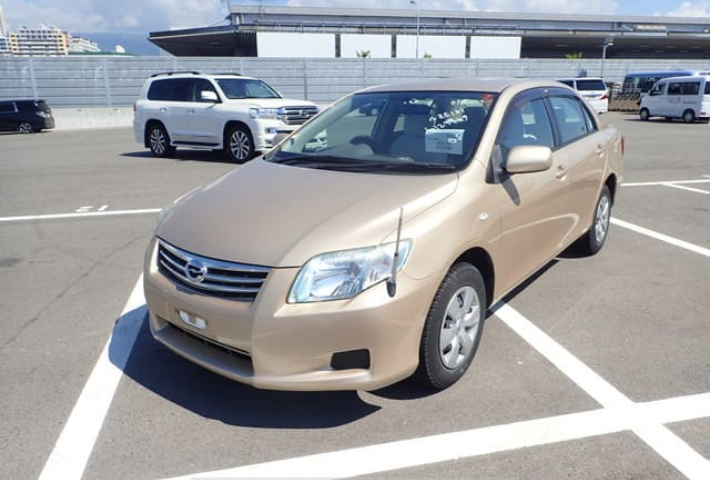Your cart is currently empty!

10 Common Toyota Corolla Axio Problems (And How To Fix Them)
If you own (or are considering buying) an Axio, then it’s good to get an idea of the Toyota Corolla Axio problems to expect, and how to fix them. You’re in the right place. As someone who has driven the Axio, I know most of its ins and outs, and by the end of this post, you will too.
The Toyota Corolla Axio has a reputation as a practical, fuel-efficient, and reliable sedan. It is a popular choice in markets like Japan, Kenya, Malawi, and other regions where compact cars are in high demand. I’ve only ever had a few chances to drive the Axio in Lilongwe, and I have to say, I really enjoyed the comfort and steering feel. And for a family sedan, the Axio offers a sporty ride. But, like any vehicle, it isn’t immune to issues. There are many Toyota Corolla Axio problems that you should know about, and I put them all together.
First of all, the most problematic model years of the Toyota Corolla Axio tend to be 2006-2010 (first-generation Axio) and some of the later 2012-2015 models. These models face mechanical and electrical complaints. The newer models (2016 onward) are generally more refined, but with fewer issues. Without further ado, here are the top problems with the Toyota Axio.
1. Transmission Issues (CVT Hesitation & Slipping)
One of the most reported Toyota Corolla Axio problems is related to the CVT transmission. Owners often complain about hesitation when accelerating, shuddering during gears, or a feeling that the transmission is “slipping” under load. These issues are especially common in the 2006–2010 and 2012–2014 models, which used early CVT designs that weren’t as durable as later versions.
The transmission problems on the Toyota Axio come from worn-out CVT belts, a lack of timely transmission fluid changes, or internal valve body failures. If ignored, the CVT problem can escalate into a complete transmission failure. Once the issue gets to that point, it can be costly to repair or replace.
To prevent major damage, you should service the CVT regularly using the correct Toyota CVT fluid. You should also pay attention to early signs of a failing transmission, like jerking or delayed response.
2. Excessive Engine Oil Consumption
Another common issue with the Toyota Corolla Axio is excessive oil consumption. This is common in models with the 1NZ-FE and 2ZR-FE engines. Owners often notice that they have to top up oil between scheduled services, sometimes as frequently as every 1,000 km. Left unchecked, this problem can lead to engine knocking, reduced performance, and even complete engine failure if the oil runs too low.
The engine oil consumption problem in the Axio comes down to worn piston rings or valve seals. These allow oil to seep into the combustion chamber, where it burns off. This problem is particularly widespread in older Axio models (2007–2013) that have racked up higher mileage.
The best solution is to monitor oil levels regularly and to fix leaks or burning symptoms early. In some cases, replacing piston rings or performing an engine rebuild may be necessary. For lighter cases, using high-quality oil with the correct viscosity and keeping up with oil change intervals can help slow down the consumption rate.
ALSO, READ: 10 Common Toyota Vitz Problems (And How to Fix Them)
3. Hard Starting/Hard Crank
Some 2008 Toyota Corolla Axio owners have reported unusually difficult engine starts. This can happen mainly in the morning or after the car is parked for a long time. The engine may crank longer than normal before firing up. This situation can become more and more frustrating over time.
The reason behind the hard start problem in the Axio may be fuel injectors, a weak starter motor, or low battery voltage. In some cases, dirty injectors may restrict fuel flow during ignition, while a worn starter struggles to turn the engine over properly. Battery health is another key factor, as insufficient voltage can lead to slow or incomplete cranking.
The best way to fix the problem is through a full engine diagnostic. Start by testing the battery and charging system. Then, check the starter motor and fuel injectors for proper operation. Replacing the faulty component usually fixes the issue.
4. High Fuel Consumption And Poor Acceleration
One of the most common Toyota Corolla Axio problems is high fuel consumption. Owners of the 2005 Toyota Corolla Axio have frequently reported poor fuel economy, with mileage figures dropping as low as 7–9 km/l. That is well below what the car typically delivers. Alongside the increased fuel consumption, drivers also notice sluggish acceleration, where the car feels unresponsive even when pressing the accelerator harder.
The main causes of the issue stem from fuel system inefficiencies, such as clogged fuel filters or dirty injectors. These can restrict the proper flow of fuel into the engine. In some cases, transmission drag adds extra load. This can make the car struggle to pick up speed. Poor maintenance or overdue servicing often worsens the problem.
To fix the issue, replace the fuel filter. Also, inspect and clean the injectors and carry out a transmission service if necessary. Be sure to keep up with regular maintenance.
ALSO, READ: 10 Common Problems With the Toyota Ractis (And How To Fix Them)
5. Electrical Wiring Faults
Some 2011 Corolla Axio owners have reported unusual electrical wiring faults. Notably, the radiator fan can keep running after the ignition is switched off. In certain cases, this issue is accompanied by stiff steering. This may suggest that the problem extends beyond the fan to other critical electrical systems.
The root causes are usually short circuits, faulty relays, or poor grounding in the wiring harness. When electrical current continues to flow despite the car being shut down. It may drain the battery and risk overheating.
The best fix is to carry out a full electrical diagnostic. Start by carefully tracing the wiring for shorts or bad connections. You should also replace the faulty relays and replace the damaged sections of the harness.
6. Steering Rack Problems
Another common issue reported by Toyota Corolla Axio owners is steering rack failure. Drivers often complain of unusual noises when turning, a loose or shaky steering feel. In more severe cases, a noticeable pull to one side while driving. These symptoms can make the ride feel very uncomfortable to handle.
The primary causes usually include worn rack bushings, damaged seals, or fluid leaks within the power steering system. Over time, these components degrade due to wear and tear, especially if the car is frequently driven on rough roads or not maintained regularly.
Fixing the problem often involves replacing worn bushings or seals. If the rack itself is worn out or leaking, your Axio may need a complete steering rack replacement. During regular inspections and maintenance, keep the power steering fluid clean to extend the life of the steering system.
ALSO, READ: 10 Common Problems With The Toyota Noah, Ranked
7. Engine Loss of Power or Stalling
Some Corolla Axio owners report instances where the engine suddenly loses power or stalls while driving. This can be dangerous if it happens in traffic or at highway speeds. Drivers often describe symptoms like hesitation during acceleration, rough idling, or the engine cutting out unexpectedly.
The common causes of stalling or loss of power in the Toyota Corolla Axio are clogged fuel injectors and dirty throttle bodies. Failing sensors such as the mass airflow sensor (MAF) or crankshaft position sensor may also cause these problems. In some cases, poor fuel quality or lack of regular servicing also contributes to the issue.
Fixing the problem usually starts with a thorough diagnostic scan to identify error codes. Cleaning or replacing the fuel injectors, throttle body, or faulty sensors often resolves the issue.
8. Hybrid System Problems
The Toyota Corolla Axio hybrid models, released from 2013 onward, feature a 1.5L hybrid system with the Toyota Hybrid System II (THS II). While these vehicles are praised for fuel efficiency, some owners report issues with battery performance, sudden drops in EV mode functionality, or warning lights related to the hybrid system. Symptoms often include reduced fuel economy, the EV mode not engaging, or the hybrid system warning light illuminating on the dashboard.
Common causes of these problems include aging hybrid battery packs and faulty sensors within the THS II system. Software glitches in the hybrid control module can cause the issue. In some cases, hybrid battery packs may lose capacity over time.
Fixing hybrid system issues typically involves running a diagnostic scan of the hybrid control module, checking battery health, and inspecting key sensors. Minor software updates or sensor replacements can resolve some issues. On the other hand, battery pack replacement may be necessary for more severe capacity loss.
ALSO, READ: Six Common Problems With The Fifth-Gen Toyota 4Runner
9. Air Conditioning & Climate Control Issues
Many Toyota Corolla Axio owners report problems with the air conditioning system. Common symptoms include weak cooling, unusual noises from the blower, or the AC failing to activate completely. Some drivers also notice fluctuating temperatures or the system only blowing warm air despite full AC settings.
These issues stem from low refrigerant levels, leaks in the AC system, or a failing blower motor. Keep an eye out for a malfunctioning climate control module. In hybrid models, additional electrical complexity can sometimes contribute to control unit faults. This can make diagnostics a little trickier.
To fix the issue, start by identifying the root cause. Recharge or repair leaks in the AC system and replace the blower motor. Also, service the climate control module. If it’s a hybrid, your Axio will need a professional inspection of the electrical circuits powering the AC and climate control systems.
10. Wheel Bearing Failure
Some Toyota Corolla Axio models from 2016–2017 have shown premature wheel bearing wear, particularly on the rear-left wheel. Owners often report humming, grinding, or unusual vibrations coming from the wheel area, sometimes at surprisingly low mileage (around 50,000 km). Do not ignore the issue when you notice it. If you leave it for a long time, the symptoms can affect handling, tire wear, and safety.
The primary causes are typically poor lubrication during manufacturing, substandard bearing materials. The problem can also result from contamination from road debris. In some cases, incorrect installation during maintenance can also accelerate wear.
Fixing the wheel bearing issue is relatively straightforward. Replace the faulty wheel bearing immediately. Doing so prevents further damage to the hub, suspension components, and tires.
Other Toyota Corolla Axio Problems
While the 10 problems above are the most frequently reported, Corolla Axio owners have also noted several less common but noteworthy issues. Though these issues are less severe, they are worth noting for pre-purchase checks or routine maintenance.
- AC performance dips: sometimes linked to low refrigerant or a failing blower motor.
- Dashboard warning lights: occasional false ABS or airbag warnings in older models.
- Infotainment quirks: touchscreen freezing, Bluetooth disconnects, or SD card recognition errors.
- Paint or trim defects: minor peeling or fading, particularly on models exposed to harsh sunlight.
- Suspension noises: creaks or rattles from bushings or struts, more common in higher-mileage vehicles.
Author Details

Our Team
Hi there! Welcome to Flagship Drive.
I’m Wilfred Nkhwazi, a passionate car lover from Africa. I created this platform to share expert insights, honest reviews, and a fresh perspective on the latest cars and automotive trends. Let’s hit the road together.
Advertisement

Recent News

